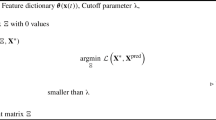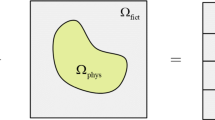Abstract
The reduced multibody system transfer matrix method can efficiently solve the generalized accelerations of a system without establishing global dynamics equations with a system inertia matrix, given the generalized coordinates and generalized velocities of the system. The equilibrium position of a multibody system is significant in the dynamics analysis, which is difficult to obtain directly. In this paper, a statics analysis method is proposed based on the reduced multibody system transfer matrix method by applying the notion of direct differentiation. The partial derivatives of generalized accelerations with respect to generalized coordinates called Jacobian matrix can be obtained easily by differentiating the transfer equations in the reduced multibody system transfer matrix method. Let the generalized velocities be zero and solve the system of nonlinear equations with zero generalized accelerations to obtain the static equilibrium position of a multibody system. The formulation and solution procedure of the proposed method are presented. The numerical examples are compared with dynamic relaxation method and the iterative method based on the first kind of Lagrange’s equation, which demonstrates the proposed approach and show computational advantages. The proposed method is straightforward, highly programmable, universal and provides a powerful tool for solving static equilibrium positions of multibody systems while extending the application of the multibody system transfer matrix method.

















Similar content being viewed by others
References
Alexandru, C.: Analytical method for determining the static equilibrium position of the rear axles guiding mechanisms of the motor vehicles. Appl. Mech. Mater. 841, 59–64 (2016). https://doi.org/10.4028/www.scientific.net/AMM.841.59
Bauchau, O.A.: Flexible Multibody Dynamics. Springer, Berlin (2011)
Brandl, H., Johanni, R., Otter, M.: An algorithm for the simulation of multibody systems with kinematic loops (1987)
Chen, F.: ADAMS 2020 Virtual Prototyping Technology from Beginner to Master. Tsinghua University Press (2021)
De Jalón, J.G., Bayo, E.: Kinematic and Dynamic Simulation of Multibody Systems: The Real-Time Challenge. Springer, New York (2012)
Del Prete, A., Tonneau, S., Mansard, N.: Fast algorithms to test robust static equilibrium for legged robots (2016)
Kane, T.R., Likins, P.W., Levinson, D.A.: Spacecraft Dynamics. McGraw-Hill, New York (1983)
Lu, Y.: Dynamics of Flexible Multibody Systems. Higher Education Press (1996)
Lu, Y., Chang, Z., Lu, Y., Wang, Y.: Development and kinematics/statics analysis of rigid-flexible-soft hybrid finger mechanism with standard force sensor. Robot. Comput.-Integr. Manuf. 67, 101978 (2021). https://doi.org/10.1016/j.rcim.2020.101978
Nandihal, P.V., Mohan, A., Saha, S.K.: Dynamics of Rigid-Flexible Robots and Multibody Systems. Springer, Singapore (2021)
Negrut, D., Dyer, A.: Adams/solver primer. MSC. Software documentation, Ann Arbor (2004)
Orozco-Magdaleno, E.C., Cafolla, D., Castillo-Castaneda, E., Carbone, G.: Static balancing of wheeled-legged hexapod robots. Robotics 9(2), 23 (2020). https://doi.org/10.3390/robotics9020023
Pestel, E.C., Leckie, F.A., Kurtz, E.F.: Matrix methods in elastomechanics. J. Appl. Mech. 31(3), 574 (1964)
Rose, G.K.: Computational methods for nonlinear systems analysis with applications in mathematics and engineering. Dissertation, Old Dominion University (2017)
Rose, G.K., Newman, B.A., Nguyen, D.T.: A path following method for identifying static equilibrium in multi-body-dynamic systems. Multibody Syst. Dyn. 45(3), 315–359 (2019). https://doi.org/10.1007/s11044-018-9618-7
Rui, X., Bestle, D.: Reduced multibody system transfer matrix method using decoupled hinge equations. Int. J. Mech. Syst. Dyn. 1(2), 182–193 (2021). https://doi.org/10.1002/msd2.12026
Rui, X., Wenhai, S., Yunzhong, S.: Transfer matrix of rigid body and its application in multibody system dynamics. J. Astronaut. 4, 82–87 (1993)
Rui, X., He, B., Lu, Y., Lu, W., Wang, G.: Discrete time transfer matrix method for multibody system dynamics. Multibody Syst. Dyn. 14(3), 317–344 (2005)
Rui, X., Bestle, D., Zhang, J., Zhou, Q.: A new version of transfer matrix method for multibody systems. Multibody Syst. Dyn. 38(2), 137–156 (2016). https://doi.org/10.1007/s11044-016-9528-5
Rui, X., Gu, J., Zhang, J., Zhou, Q., Yang, H.: Visualized simulation and design method of mechanical system dynamics based on transfer matrix method for multibody systems. Adv. Mech. Eng. 9(8), 168781401771472 (2017). https://doi.org/10.1177/1687814017714729
Rui, X., Bestle, D., Wang, G., Zhang, J., Rui, X., He, B.: A new version of the Riccati transfer matrix method for multibody systems consisting of chain and branch bodies. Multibody Syst. Dyn. 49(3), 337–354 (2020). https://doi.org/10.1007/s11044-019-09711-2.
Rui, X., Zhang, J., Wang, X., Rong, B., He, B., Jin, Z.: Multibody system transfer matrix method: the past, the present, and the future. Int. J. Mech. Syst. Dyn. 2(1), 3–26 (2022). https://doi.org/10.1002/msd2.12037
Schiehlen, W. (ed.): Multibody Systems Handbook, vol. 6. Springer, Berlin (1990)
Shabana, A.A.: Dynamics of Multibody Systems. Cambridge University Press, Cambridge (2020)
Shen, J., Dong, D.: Calculation for static balance of rigid bars systems with multiple degrees of freedom. J. Shanghai Marit. Univ. 24(02), 146–149 (2003)
Sun, J., Yu, T., Dong, P.: Evaluation of 3D slope stability based on the minimum potential energy principle. Comput. Geotech. 146, 104717 (2022). https://doi.org/10.1016/j.compgeo.2022.104717
Wittenburg, J.: Dynamics of Systems of Rigid Bodies, vol. 33. Teubner, Stuttgart (1977)
Acknowledgements
The authors are grateful for the support from the Multi-domain System Model Simulation and Collaborative Verification Technology (JCKY2020606B004), the National Natural Science Foundation of China (Grant No. 11902158), and the Natural Science Foundation of Jiangsu Province (No. BK20190438).
Author information
Authors and Affiliations
Contributions
Xizhe Zhang, Xiaoting Rui and Jianshu Zhang conceived of the presented idea. Xizhe Zhang and Jianshu Zhang developed the theory. Xizhe Zhang performed the computations and wrote the main manuscript text. Jianshu Zhang and Junjie Gu provided funding support. Xizhe Zhang and Lina Zhang verified the analytical methods. Jianshu Zhang contributed to the improvement of the manuscript. All authors discussed the results and reviewed the manuscript.
Corresponding author
Ethics declarations
Competing interests
The authors declare no competing interests.
Additional information
Publisher’s Note
Springer Nature remains neutral with regard to jurisdictional claims in published maps and institutional affiliations.
Appendix: Rigid body mechanics
Appendix: Rigid body mechanics
Herein, the kinematics and dynamics equations of a rigid body are discussed. First consider the point \(P\), which has no relative motion to the rigid body’s body-fixed coordinate system, as shown in Fig. 1. The position vector of the point \(P\) can be expressed as
The time derivative of Eq. (52) is the equation for the translational velocity vector at the point \(P\), namely
where \(\overset{\scriptscriptstyle \rightharpoonup}{r }\) is the position vector and \(\overset{\scriptscriptstyle \rightharpoonup}{\omega }\) is the angular velocity vector. The overhead dot (solid point) denotes the absolute derivatives with respect to the inertial coordinate system.
Since there is no relative motion between the point \(P\) and the body-fixed coordinate system of the rigid body, the following equation is available:
The translational and angular acceleration vector of the point \({P}\) on the rigid body in the global inertial coordinate system could be obtained by taking the derivative of Eqs. (53) and (54) with respect to time, respectively [2, 24]:
The acceleration vector of the center of mass can be obtained by setting the point \(P\) as the center of mass \(C\), namely
The dynamics equations for a rigid body can be obtained from Newton’s law and the angular momentum theorem of a rigid body [27]:
where \(m\) is the mass of the rigid body and \({{ \overset{\scriptscriptstyle \rightharpoonup}{\overset{\scriptscriptstyle \rightharpoonup}{J}}}_{R}}\) is the inertia tensor of the spatially moving rigid body with respect to the root marker \(R\). \({{\overset{\scriptscriptstyle \rightharpoonup}{F}}{^{\mathrm{{Ex}}}}}\) is the resultant external force acting on the body, and \(\overset{\scriptscriptstyle \rightharpoonup}{M}{_{R}^{\mathrm{{Ex}}}}\) denotes the resultant external torque with respect to the root marker \(R\). Substituting Eq. (57) into Eq. (59), the dynamics equations are obtained as follows:
Then the case when the point \(P\) has relative motion to the body-fixed coordinate system of the rigid body is addressed. Equation (52) still holds. The motion of the point \(P\) relative to the rigid body needs to be considered for the acceleration vector. The translational and angular acceleration vectors of the tip marker \(T\) in the global inertial coordinate system are as shown below [10, 24, 27]:
where the local derivative with respect to the body-fixed coordinate system \(R{x}_{R}y_{R}z_{R}\) is expressed as a hollow point ∘ to distinguish it from the absolute derivative with respect to the inertial coordinate system expressed as a solid point.
Rights and permissions
Springer Nature or its licensor (e.g. a society or other partner) holds exclusive rights to this article under a publishing agreement with the author(s) or other rightsholder(s); author self-archiving of the accepted manuscript version of this article is solely governed by the terms of such publishing agreement and applicable law.
About this article
Cite this article
Zhang, X., Rui, X., Zhang, J. et al. Statics analysis based on the reduced multibody system transfer matrix method. Multibody Syst Dyn (2023). https://doi.org/10.1007/s11044-023-09916-6
Received:
Accepted:
Published:
DOI: https://doi.org/10.1007/s11044-023-09916-6




